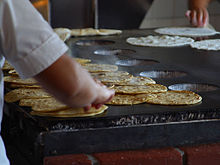Flatbread: Difference between revisions
Appearance
Content deleted Content added
Same as lavash. |
|||
| Line 29: | Line 29: | ||
* [[Laobing]] ([[China]]) |
* [[Laobing]] ([[China]]) |
||
* [[Lavash]] (Eastern [[Mediterranean]]) |
* [[Lavash]] (Eastern [[Mediterranean]]) |
||
* [[Lahvash]] |
|||
* [[Laxoox]] ([[Somalia]]) |
* [[Laxoox]] ([[Somalia]]) |
||
* [[Lefse]] ([[Nordic countries|Nordic]]) |
* [[Lefse]] ([[Nordic countries|Nordic]]) |
||
Revision as of 21:58, 9 October 2008



A flatbread is a simple bread made from flattened dough. Many flatbreads are unleavened—made without yeast or sourdough culture. They can range from one millimeter to a few centimeters thick. Flatbread was already known in Ancient Egypt and Sumer.
Religious significance
The term unleavened breads can also refer to breads which are not prepared with leavening agents. These flatbreads holds special religious significance to adherents of Judaism and Christianity. Jews consume unleavened breads such as Matzo during Passover. They are also used in the Western Christan liturgy when Christians celebrate the Eucharist.
Examples
- Aish Mehahra (Egypt)
- Barbari bread (Persian)
- Bazlama (Turkey)
- Bhakri (India)
- Bhatura (India)
- Bing (China)
- Casabe (South America, Caribbean)
- Chapati (India)
- Crêpe (France)
- Crisp bread (Nordic)
- Flammkuchen (France)
- Flatbrød (Norway)
- Flatkaka (Iceland)
- Focaccia (Italy)
- Green onion pancake (China)
- Injera (Ethiopia),(Eritrea)
- Khanom buang (Thailand)
- Laobing (China)
- Lavash (Eastern Mediterranean)
- Laxoox (Somalia)
- Lefse (Nordic)
- Luchi (East India and Bangladesh)
- Malooga (Yemeni)
- Markook (Levant)
- Matzo (Jewish)
- Naan (Central and South Asia)
- Ngome (Mali)
- Pancake (Canada and United States)
- Pane carasau (Sardinia)
- Papadum (India, Sri Lanka)
- Paratha (India, Sri Lanka)
- Piadina (Italy)
- Pide (Turkey)
- Pita (Eastern Mediterranean and Middle East)
- Pizza is also based on flatbread.
- Puri (India)
- Roti (Central and South Asia)
- Rieska (Finland)
- Sacramental bread (Roman Catholic and some Protestants)
- Sanchuisanda (the Qiang people of China) -- made of wheat flour and baked in ashes at the side of an open wood fire. The finished loaf is covered in ashes which are blown and patted off. The name literally means "three blows, three hits" and refers to this post-cooking cleaning.
- Sangak (Persian)
- Taftoon Bread (Persian)
- Tortilla (Mexico)
- Tunnbröd (Sweden)
- Yufka (Turkey)
- Mandezi (African)
- Podpłomyk (Poland)
See also
References
- Sanchuisanda is described in "Peoples of China's Far Provinces", by Wong How-Man, National Geographic, March 1984.
External links
Wikimedia Commons has media related to Flatbread.
